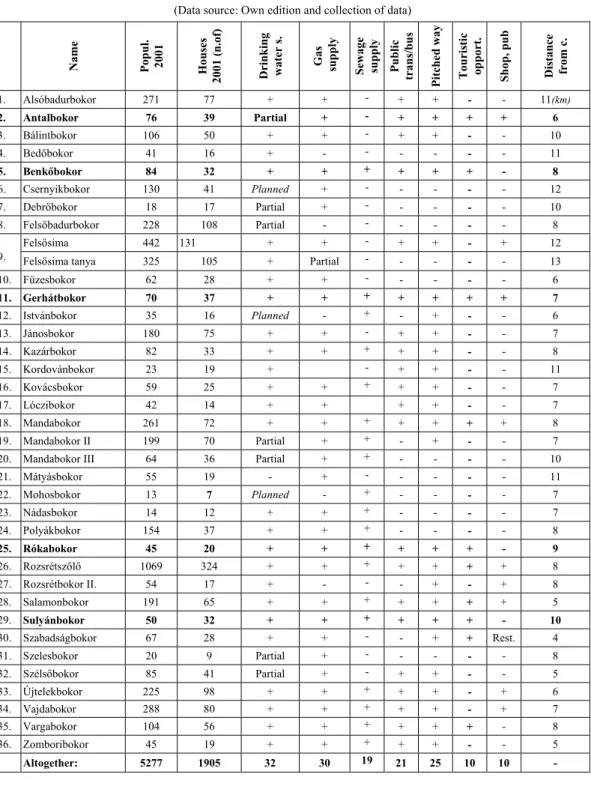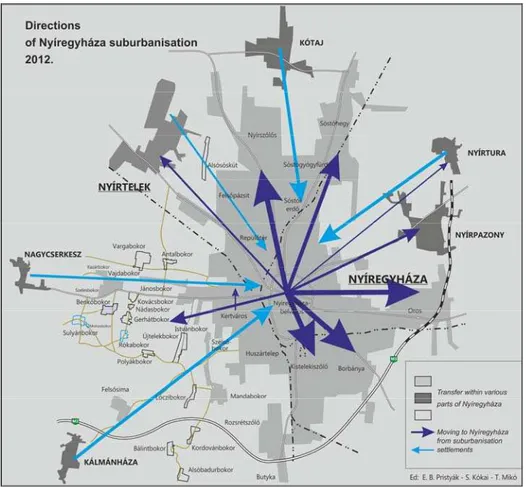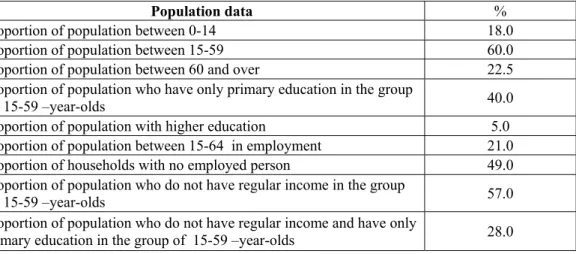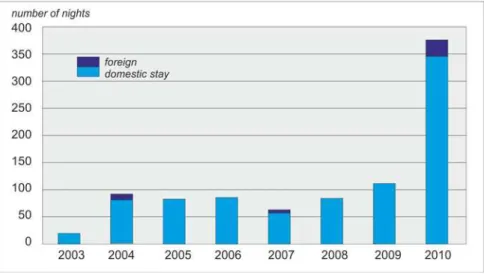ISSN 11222211--11227733, E-ISSN 22006655--33440099 Article no. 223322110088--661133
http://istgeorelint.uoradea.ro/Reviste/Anale/anale.htm
D
D
E
E
S
S
C
C
R
R
I
I
P
P
T
T
I
I
O
O
N
N
O
O
F
F
T
T
H
H
E
E
B
B
O
O
K
K
O
O
R
R
S
S
A
A
N
N
D
D
T
T
H
H
E
E
I
I
R
R
O
O
P
P
P
P
O
O
R
R
T
T
U
U
N
N
I
I
T
T
I
I
E
E
S
S
I
I
N
N
T
T
O
O
U
U
R
R
I
I
S
S
M
M
E
ErriikkaaBB..PPRRIISSTTYYÁÁKK
College of Nyíregyháza, Faculty of Tourism and Geography 4400 Nyíregyháza Sóstói út. 31/b., Hungary, e-mail: pristyak@nyf.hu
Abstract: A ’bokortanya’ is a special type of settlement, some examples of these can be found west of Nyíregyháza. At the beginning of the ’nought years’ we only saw mouldering ’bokors’, while today the situation is rather different. During this period the town development strategies, real infrastructural and other improvements and developments contributed to the actual social-economical revitalisation of the ’bokors’. During the past decades there have been changes. Significant differences emerged among the ’bokors’, the dying and outstanding settlements have started to become distinct. The functions of ’bokors’ have shifted, and the lifestyle of the inhabitants has changed, therefore these settlements have differentiated. Based on my research I have categorised them. Visiting ’bokors’ as a unique type of settlement can only be of interest for a small group of experts. It is not likely that ’bokors’ will appear as a tourist destination themselves; however, it is realistic to assume that they can provide a supplementary programme and accommodation for visits of other purposes. They can provide attraction and services that are a real experience for tourists. Tourism itself does not mean a complex solution for any of the ’bokors’at present; it may, however, provide a supplementary income source for the local population, and also make the landscape/settlements more attractive. They can make the opportunities in a town touristically developing more colourful and unique and Nyíregyháza can help improve them in this process.
Key words: suburbanisation, hamlet, revitalisation, rural tourism
* * * * * *
INTRODUCTION
The events and research carried out in 2003 on the 250th anniversary of ’settling’ have greatly contributed to the resurrection of the ’bokors’ and tirpak traditions. However, the basis of this revitalisation of the ’bokors’ is some other issue. It has been 20 years since the political changes in the country; the town development strategies, real infrastructural and other changes and developments make this revitalisation possible. At the beginning of the ’nought years’ we only saw mouldering ’bokors’, while today the situation is rather different (table 1).
During the past 20 years significant differences emerged among the ’bokors’, the dying and developing settlements have started to become distinct. The decrease of the population has slowed down, but there have been huge diversions from the average.
Table 1. Social and service characteristics of the ’bokors’ (Data source: Own edition and collection of data)
Gyula Krúdy, who was born in Nyíregyháza, wrote that ’tirpaks used to blush, be ashamed and get angry because of this deragatory term.’ This has changed and hopefully has found its appropriate place. Nyíregyháza has benefited a lot from the ’settling’ and the civic developments that followed. The identity of ’tirpaks’ was restored.
Name Popul. 2001 Ho
us
es
2001 (
n
.of
)
Drinking water s.
Ga
s
supply Sewage supply Public
trans/bus
Pitche
d way
Touristic opport. Shop, pub Distance fro
m
c.
1. Alsóbadurbokor 271 77 + + - + + - - 11(km)
2. Antalbokor 76 39 Partial + - + + + + 6
3. Bálintbokor 106 50 + + - + + - - 10
4. Bedőbokor 41 16 + - - - - - - 11
5. Benkőbokor 84 32 + + + + + + - 8
6. Csernyikbokor 130 41 Planned + - - - - - 12
7. Debrőbokor 18 17 Partial + - - - - - 10
8. Felsőbadurbokor 228 108 Partial - - - - - - 8
9.
Felsősima 442 131 + + - + + - + 12
Felsősima tanya 325 105 + Partial - - - - - 13
10. Füzesbokor 62 28 + + - - - - - 6
11. Gerhátbokor 70 37 + + + + + + + 7
12. Istvánbokor 35 16 Planned - + - + - - 6
13. Jánosbokor 180 75 + + - + + - - 7
14. Kazárbokor 82 33 + + + + + - - 8
15. Kordovánbokor 23 19 + - + + - - 11
16. Kovácsbokor 59 25 + + + + + - - 7
17. Lóczibokor 42 14 + + + + - - 7
18. Mandabokor 261 72 + + + + + + + 8
19. Mandabokor II 199 70 Partial + + - + - - 7
20. Mandabokor III 64 36 Partial + + - - - - 10
21. Mátyásbokor 55 19 - + - - - - - 11
22. Mohosbokor 13 7 Planned - + - - - - 7
23. Nádasbokor 14 12 + + + - - - - 7
24. Polyákbokor 154 37 + + + - - - - 8
25. Rókabokor 45 20 + + + + + + - 9
26. Rozsrétszőlő 1069 324 + + + + + + + 8
27. Rozsrétbokor II. 54 17 + - - - + - + 8
28. Salamonbokor 191 65 + + + + + + + 5
29. Sulyánbokor 50 32 + + + + + + - 10
30. Szabadságbokor 67 28 + + - - + + Rest. 4
31. Szelesbokor 20 9 Partial + - - - - - 8
32. Szélsőbokor 85 41 Partial + - + + - - 5
33. Újtelekbokor 225 98 + + + + + - + 6
34. Vajdabokor 288 80 + + + + + - + 7
35. Vargabokor 104 56 + + + + + + - 8
36. Zomboribokor 45 19 + + + + + - - 5
Changes here started to happen more slowly after the political changes in the country than in other bigger settlements. The quick development of Nyíregyháza only reached the ourskirts a whole decade later. This slow shift can also be viewed as delay; however, the economic situation can have little impact on the thinking of a society. There have been significant changes in the past decade, the ’bokors’ have differentiated, as I have previously published (Pristyák, 2000; 2003; 2011). De-urbanisation reached other areas of the town first; construction has only started in the ’bokors’ in the past few years, since 2005 in particular; therefore this part of town is now an important area of suburbanisation for Nyíregyháza (figure 1).
Figure 1. Directions of Nyíregyháza suburbanisation, 2012 (Source: Own edition)
THE TOWN’S CONCEPTS
The provision of quality life circumstances in the concept of long term settlement development of Nyíregyháza includes an operative programme about development and protection of built-up environment. The aim of this programme is ’the development of the town and its surroundings while preserving and further developing the specialties, traditional settlement/landscape pecularities of individiual areas.’
The development categories of the peripherial built-up areas and building regulations relating to them were determined in the settlement structure and regulation plan of the town.
2. due to their place in the settlement structure areas that are marked for economic development: Zomboribokor, Szabadságbokor;
3. support of settlement areas for recreational purposes/development;
4. settlement areas marked for conservation purposes: Rókabokor, Sulyánbokor;
5. settlement areas with agriculture and large-size lands: Mandabokor I., Manda-bokor II., Alsóbadurbokor, Füzesbokor, Mátyásbokor, Antalbokor, Gerhátbokor, Mohosbokor, Bálintbokor, Hármastanya, Nádasbokor, Bedőbokor, Istvánbokor, Polyákbokor, Benkőbokor, Kazárbokor, Szelesbokor, Csernyikbokor, Kordovánbokor, Kovácsbokor, Debrő-bokor, Felsőbadurbokor, Lóczibokor, Felsősima (tanyák).
Generic developments that apply to the ’bokors’: - improving accessibility of ’bokors’;
- provision of healthy drinking water in the administrative area of the town;
- extension of the drainage system, updating the cleaning system of wastewater, construction of replacements of local public utilities in areas where it is not feasible economically;
- support for unskilled/unqualified adults in achieving skills/qualifications and work experience; - preservation of the characteristics of ’bokors’;
- differentiated development of various ’bokors’ based on their particular roles;
- development of complex labour-market models for the gypsies, the disadvantaged and the permanently unemployed groups;
- projects social economics;
- improving tolerance towards the disadvantaged groups; - wide distribution of health prevention.
SOCIAL PROVISION, SERVICES
The level of service in these settlements can only be conluded from the data provided. There are not enough services in the area: the number of places for nurseries (3-5 years) is 138, the utilisation level is close to 100%. Due to the reorganisation of the primary school system provided by the local council there is only one school in Rozsretszolo, where they provide a class a year from first to eighth year, altogether 13o pupils. There is an opportunity for children to attend a boarding school in Nyirszolos. Child care for babies (under 3) and health care provision is lacking; however, there are some social care type of services (such as meals provided in Benkobokor).
Table 2 describes the data regarding education, employment and other information of the local population. It clearly indicates that the ratio of ageing population is still high (table 2).
Table 2. Data regarding the social composition of the population of ‘bokors’, 2008 (Data source: Town Development Strategy of Nyiregyhaza)
Population data %
Proportion of population between 0-14 18.0 Proportion of population between 15-59 60.0 Proportion of population between 60 and over 22.5 Proportion of population who have only primary education in the group
of 15-59 –year-olds 40.0 Proportion of population with higher education 5.0 Proportion of population between 15-64 in employment 21.0 Proportion of households with no employed person 49.0 Proportion of population who do not have regular income in the group
of 15-59 –year-olds 57.0 Proportion of population who do not have regular income and have only
This area plays an important part in the transport system of Nyíregyháza, as ring roads, national roads and motorway junctions avoiding the internal part of the town have been built. A Lego factory is being built at the moment. A more complete integration into the transport system requires the further development of the road systems. The most significant change in public transport in recent years is the fact that 21 ’bokors’ have been included in the local bus routes. The roads are tarmac, the turning points not always though. Social care in the ’bokors’ have been taken over from the local council by the church; the Joób Olivér Szeretetintézmény run by the Kertvárosi Evangélikus Egyház (that is responsible for the west part of the town and the ’bokors’) has taken up these tasks with the help of ’bokor janitors’ and family helpers. Their headquarters are at 23 Benkőbokor.
TOURISM IN THE ’BOKORS’
The greatest valuable of the ’bokors’ is the special, unique settlement-structure features, their settlement- morphological picture and ’tirpak’ traditions. Awareness of these should be increased. They do not really have other cultural or unique agro-touristic values. The conservation of traditions takes many forms; particular events that link into equestrian and gastronomic tourist products.
’Tirpak’ events are quite regular, the number of visitors has increased over the years; the gastronomic and other traditions may interest the young who have some connections with ’tirpaks’ and ’bokors’. Civic societies form and more events are organised by the local Lutheran church as well. The ’bokors’ can also join the TDM (Tourist Destination Management) – this is current, local organisation in tourism – with a slogen of ’Nyirseg tourist magic’.
Besides rural tourism there are opportunities for active tourism as well, such as walking, biking and riding. The town supports the ’bokors’ changes in order to make them provide for rural tourism. It is not likely that ’bokors’ will appear as a tourist destination themselves; however, it is realistic to assume that they can provide a supplementary programme and accommodation, and so increase their turnover. This small area can become competitive if visitors spread its good reputation and return here and also if it can provide attraction and services that are a real experience for tourists and represent better price-value ratio when compared to competitors (Hanusz, 2010). Officially in the area of 36 ’bokors’ there are five places where one can find private accommodation. In reality, there are two where they deal with tourism. There is no commercial accommodation. The Lutheran church also offers guest rooms.
Tourist oportunities in the ’bokors’:
- the greatest valuable of the ’bokors’ is the special, unique settlement-structure features, their settlement- morphological picture and their modest ’tirpak’ traditions;
- they do not really have other cultural or unique agro-touristic values;
- the conservation of traditions takes many forms; particular events that link into equestrian and gastronomic tourist products;
- rural tourism near to a big city.
Attractions that have a county or national reach should be focussed on, as they are the ones that will make people living outside the county borders to travel and stay here.
Tourist products suggested to be developed are as follows:
- tourist products that can shape the image (rural, eco- and cultural tourism);
- other general tourist products (rural tourism, biking, tourism for the young and elderly); - support to participate in tourism, just like in the cases of villages that have no special attractions. Accommodation (table 3):
- private accommodation is available at five places (32 beds), these are mostly ’village accommodation’;
- in fact, there are two places where they deal with tourists; the outstanding one is Bihari-Tanya; - no commercial accommodation;
- guest rooms of the lutheran church, 12 beds;
Table 3. Data of Nyíregyháza private accommodation (Data source: Nyíregyházi TDM)
year
No of guests (person)
Total guest
nights Foreginer guest nights
No of hosts (person)
No of rooms
No of beds
No of beds available
2000 2764 12402 7358 43 - - 313
2001 2740 15047 8061 54 - - 362
2002 2791 17274 8951 58 - - 449
2003 2044 12332 7342 58 - - 409
2004 1834 8070 4398 58 - - 412
2005 1809 7848 2260 67 182 445 503
2006 1831 9510 3026 56 147 340 394
2007 2108 8018 3265 59 141 336 391
2008 2157 7159 2309 66 162 376 429
2009 1500 5371 3316 60 156 372 428
’Tirpak’ events, organisations, publications:
- Tirpák Lovas Napok (Equestrian Days) / Tirpák Hétvége (Weekend) on Bihari-tanya; - days in Vajdabokor or Meeting of local minorities in Mandabokor;
- in Sosto Village Museum they celebrate Whitsun with ’tirpak’ traditions; - events organised by local Lutheran church;
- publication of E-misszió (E-mission Nature and - Environment Protection Association): Friendly ’bokors’, Guide to the natural resources of ’bokors’ and hamlets around Nyíregyháza – this is a promotive, very high standard and free publication.
The number of visitors has increased over the years; the gastronomic and other traditions may interest the young who have some connections with ’tirpaks’ and ’bokors’:
- association for the Population of ’Bokors’ – civic society that is the most active in maintaining traditions;
- Tirpák Kulturális Egyesület (’Tirpak’ Cultural Association);
- Vajdabokori Tirpák Népzenei Együttes (Vajdabokor ’Tirpak’ Folk Music Ensemble); - Folk Choir and Dancers of Mandasi Bokortanya Club;
- Nyírség Turizmusáért Egyesület (Association for Tourism of Nyírség); - Tirpák dishes – Dr. Bodnár Zsuzsa, ethnography.
Progress in tourism of ’bokors’:
- in publication of the town Nyíregyháza provides some information and a picture occasionally (usually with the Village Museum);
- ’Tirpak’ Days have been organised on Bihar-tanya for the past 6 years, it is close to the ’town day’ and includes equestrian and gastronomic programmes;
- 17. Rókabokor, 11. Benkőbokor houses are monument type buildings, Róka and Sulyán bokor have protected settlement structures;
- ’Tirpak Inn’ next to the main road No 36 in Szabadságbokor, with ’tirpak’ food on the menu and opportunities for ’tirpak’ weddings;
- gastronomic collections and ’tirpak’ speacialties (e.g. pucóka (gnocchi type pasta), kúknya, laskafélék (different kinds of pasta), mákostengeri (sweetcorn with poppy seeds);
- increase of village accommodation;
- events organised by the Association for the Population of ’Bokors’ (linking to the ’town day’). The tourist development of ’bokors’ is one of the many strategic objectives of Nyíregyházi TDM, as this town offers complex touristic products and tourism itself is an important sector:
a) Utilisation of the town’s excellent spa water and health opportunities as a main tourist sector; b) Tourist developments based on cultural heritage in the city centre;
d) Sustainable economy, based on the characteristics and skills, within which tourism is an important factor;
e) Developed local infrastructure, which satisfy the requirements of quality tourism; f) Development of human resources is a basic requirement for tourism.
Numerous studies have focussed on the dissolution and depopulation of the ’bokors’; however, there have only been a few on their tourist exploitation. One way of saving the system of ’bokors’ is to fill them with sensible tourist programmes. ’Tirpak’ Days will be an essential part of the equestrian evens around town, as tourists who take part in fox-hunting and riding in carriages will look for places that have been made appropriate for tourists during the ’tirpak’ weekends; these places can also serve as attractions during any season of the year (Nyíregyházi TDM 2011).
As you can see from figure 2, private accommodations have a varying amount of guests from year to year. These are greatly affected in any given year by the events that are organised in the ’bokors’ as well as in town (’Tirpak’ weekend, events in ’bokors’ during town day, ’tirpak’ wedding, etc.). In addition, any particular provider’s turnover canbe affected by their own marketing activities (Sulyánbokor Kentaur-tanya not functioning, church events etc.) (figure 2).
Figure 2. Turnover of Bihari tanya (Szabadságbokor) (Source: proprietorial statement/reference, own edition)
The biggest and best-known accommodations are the Bihari-tanya and the Lovas Panzió in Antalbokor. This is a thriving community, the farmers still live there in their own houses, and keep horses, ducks and other animals. This a village accommodation for 2x10 people, with a stone-wooden and clay-and -straw - mortar guesthouse. They have been active members of the county’s rural tourism association since 1994. They can offer more and more accommodation as well as programmes, such as horse riding, riding in a carriage, horse sledging, pig killing, clay forming and pottery; events such as coach driving, the event being Tirpak Days. In 2010 the number of guest nights exceeded 350. Based on the commentaries of the owners they had guests from Nyíregyháza and Budapest and its surrounding areas. The attraction of Nyíregyházi Zoo also contributed to the increase of guest turnover, adding to the individual marketing activities.
SUMMARY
The function of ’bokors’ has partially changed, the lifestyle of those living there show a great variation and the ’bokors’ themselves differentiated. Based on my research I categorise them as follows (Pristyák, 2011):
1. ’Bokors’ arranged as villages, one or two main streets and hopefully further economic growth: Felsősima, Gerhátbokor, Jánosbokor, Mandabokor, Rozsrétzőlő, Rozsrétbokor, Salamonbokor, Szélsőbokor, Újtelekbokor, Vargabokor, Vajdabokor, Zomboribokor, Szabadságbokor. In these settlements the distance to reach workplaces and services is acceptable, and the prices of properties provide an opportunity to build family homes with gardens. These renewed ’bokors’ share some similarities with ’dormant villages’.
2. Agriculture and family farming are dominant: Alsóbadurbokor, Antalbokor, Bálintbokor, Bedőbokor, Benkőbokor, Csernyikbokor, Debrőbokor, Felsőbadurbokor, Felsősima, Füzes-bokor, Istvánbokor, Kazárbokor, Kordovánbokor, Kovácsbokor, Lóczibokor, Mandabokor I., Mandabokor II., Mátyásbokor, Mohosbokor, Nádasbokor, Polyákbokor, Szelesbokor. Besides the more significant agricultural husbandry there is also a tendency to keep houses as weekend cottages and to ractice closed garden cultivation. Older population is present in a high ratio.
3. Bokors with tourist basis: Antalbokor, Benkőbokor, Rókabokor, Sulyánbokor, Tamás-bokor that belongs to Nagycserkesz. The two protected monuments and the protection of Róka- és Sulyánbokor is not an outstanding result, the town was due to do this to catch up, and it does strengthen the touristic function of the ’bokors’. In some places recreational purposes will come to the foreground. Besides husbandry, recreational and rural tourism will provide an opportunity to explore unused resources, which may result in an income. The effects of agglomerating and suburbanizing processes influence from sparse homesteads (bokortanyák) to small towns. These facts present such a challenge to the economy, local residents and connections of Nyíregyháza that should have been solved immediately well before (Pristyák & Kókai, 2012).
People who deal with tourism in the ’bokors’ would have benefited from avoding the pitfalls of touristic ’self-development’. To make this more efficient with the help of experts. Even other scientific or professional circles (etnography, archives, history, geography) ’acknowledging’ them would have raised interest.
It is not likely that ’bokors’ will appear as a tourist destination themselves; however, it is realistic to assume that they can provide a supplementary programme and accommodation. It can provide attraction and services that are a real experience for tourists and represent better price-value ratio when compared to competitors. Tourism at present does not mean a complex solution for any of the ’bokors’. It may, however, provide a supplementary income source for the local population, and also make the landscape/settlements more attractive. They can make the opportunities in a town touristically developing more colourful and unique and make up for anything missing in Nyíregyháza.
REFERENCES
Beluszky P. (1968), A nyíregyházi tanyabokrok földrajzi vizsgálata. Földrajzi Közlemények.
Frisnyák S. szerk. (2003), Nyíregyháza, Előadások a város újratelepítésének 250. évfordulóján, Kiadja a Nyíregyházi Főiskola Földrajz Tanszéke, Nyíregyháza, p. 224.
Hanusz Á. (2010), A TDM szerepe a falusi rendezvények turisztikai termékké fejlesztésében. In. Hanusz Á. (szerk.): In: A helyi és térségi TDM szervezetek, Kiadja Nyíregyháza MJV és a NYF TTIK TFI. pp. 35-46.
Kujbusné Mecsei É. (2001), PRO MEMORIA Nyíregyházi összeírások (1752-1850), forrásválogatás, Kiadja a Szabolcs-zatmár-Bereg Megyei Levéltár, II. közlemények 29. Nyíregyháza 2003 p. 566.
Lőrincz K. (2005), „A nyíregyházi bokortanyák revitalizációjának lehetőségei” szakdolgozat, Szent István Egyetemen. Pristyák E. (2001), A bokortanyák helyzete, a fejlődés lehetőségei, In: Nyírségi Földrajzi Napok előadásai, Szerk.: Boros L.,
Nyíregyháza, 2001. pp. 171-182.
Pristyák E. B. (2011), A bokortanyák differenciálódása az elmúlt 20 évben, In: Geográfiai folymatok térben és időben, Tanulmánykötet Dr. Hanusz Árpád 65. születésnapja tiszteletére, Szerkesztette: Dr. Kókai S. Nyíregyháza. pp. 45-61. Pristyák E.B., Kókai S. (2012), Az agglomerálódás és az szuburbanizáció jellemzői a Nyíregyházi településeggyüttesben,
In: Településföldrajzi tanulmányok 2012/2, Szerk Csapó T., Kiadja a Nyugat-magyarországi Egytem, Szombathely, pp. 87-103.
Szigetvári Cs. (2011), Barátságos bokortanyák - Kalauz a Nyíregyháza környéki bokortanyás és tanyás térség természeti értékeihez, E-misszió Természet- és Környezetvédelmi Egyesület kiadványa. Nyíregyháza.
*** (2010), Nyíregyháza Megyei Jogú Város Integrált Városfejlesztési Stratégiája http://www.nyiregyhaza.hu/index.php,. december 27.
*** Nyíregyházi TDM tájékoztatásai.
*** Településrendezési terveinek felülvizsgálata jóváhagyott dokumentáció.
*** Városlakók életminőségi vizsgálata.. Nyíregyháza Megyei Jogú Város Polgármesteri Hivatal Szociális Irodája és a Debreceni Egyetem Egészségügyi Kar Alkalmazott Társadalomtudományi Tanszéke 2008-as kutatássorozata And thank you to Agnes GREX.A.
Submitted: Revised: Accepted and published online




